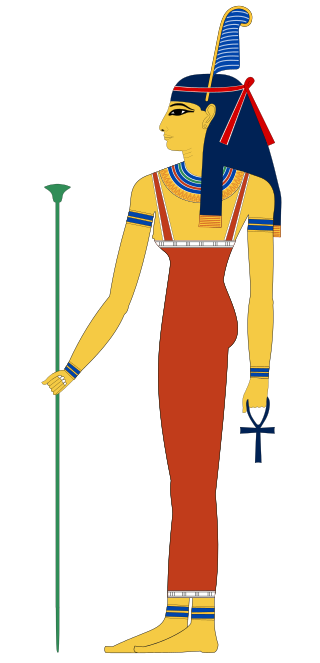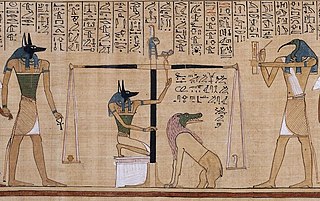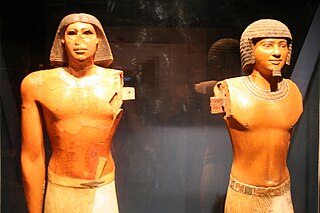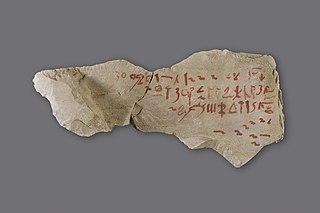Related Research Articles

Ancient Egypt was a civilization in Northeast Africa situated in the Nile Valley. Ancient Egyptian civilization followed prehistoric Egypt and coalesced around 3100 BC with the political unification of Upper and Lower Egypt under Menes. The history of ancient Egypt occurred as a series of stable kingdoms, separated by periods of relative instability known as Intermediate Periods: the Old Kingdom of the Early Bronze Age, the Middle Kingdom of the Middle Bronze Age and the New Kingdom of the Late Bronze Age.

A scribe is a person who serves as a professional copyist, especially one who made copies of manuscripts before the invention of automatic printing.

Ammit was an ancient Egyptian goddess with the forequarters of a lion, the hindquarters of a hippopotamus, and the head of a crocodile—the three largest "man-eating" animals known to ancient Egyptians. In ancient Egyptian religion, Ammit played an important role during the funerary ritual, the Judgment of the Dead.

Maat or Maʽat comprised the ancient Egyptian concepts of truth, balance, order, harmony, law, morality, and justice. Ma'at was also the goddess who personified these concepts, and regulated the stars, seasons, and the actions of mortals and the deities who had brought order from chaos at the moment of creation. Her ideological opposite was Isfet, meaning injustice, chaos, violence or to do evil.

The Book of the Dead is an ancient Egyptian funerary text generally written on papyrus and used from the beginning of the New Kingdom to around 50 BC. The original Egyptian name for the text, transliterated r(ꜣ)w n(y)w prt m hrw(w), is translated as Book of Coming Forth by Day or Book of Emerging Forth into the Light. "Book" is the closest term to describe the loose collection of texts consisting of a number of magic spells intended to assist a dead person's journey through the Duat, or underworld, and into the afterlife and written by many priests over a period of about 1,000 years. Karl Richard Lepsius introduced for these texts the German name Todtenbuch, translated to English as Book of the Dead.

The Great Hymn to the Aten is the longest of a number of hymn-poems written to the sun-disk deity Aten. Composed in the middle of the 14th century BC, it is varyingly attributed to the 18th Dynasty Pharaoh Akhenaten or his courtiers, depending on the version, who radically changed traditional forms of Egyptian religion by replacing them with Atenism. The hymn bears a notable resemblance to the biblical Psalm 104.

The Middle Kingdom of Egypt is the period in the history of ancient Egypt following a period of political division known as the First Intermediate Period. The Middle Kingdom lasted from approximately 2040 to 1782 BC, stretching from the reunification of Egypt under the reign of Mentuhotep II in the Eleventh Dynasty to the end of the Twelfth Dynasty. The kings of the Eleventh Dynasty ruled from Thebes and the kings of the Twelfth Dynasty ruled from el-Lisht.

The ancient Egyptians had an elaborate set of funerary practices that they believed were necessary to ensure their immortality after death. These rituals included mummifying the body, casting magic spells, and burials with specific grave goods thought to be needed in the afterlife.

Wisdom literature is a genre of literature common in the ancient Near East. It consists of statements by sages and the wise that offer teachings about divinity and virtue. Although this genre uses techniques of traditional oral storytelling, it was disseminated in written form.

The Pyramid Texts are the oldest ancient Egyptian funerary texts, dating to the late Old Kingdom. They are the earliest known corpus of ancient Egyptian religious texts. Written in Old Egyptian, the pyramid texts were carved onto the subterranean walls and sarcophagi of pyramids at Saqqara from the end of the Fifth Dynasty, and throughout the Sixth Dynasty of the Old Kingdom, and into the Eighth Dynasty of the First Intermediate Period. The oldest of the texts have been dated to c. 2400–2300 BCE.

Ptahhotep, sometimes known as Ptahhotep I or Ptahhotpe, was an ancient Egyptian vizier during the late 25th century BC and early 24th century BC Fifth Dynasty of Egypt.

Instruction of Amenemope is a literary work composed in Ancient Egypt, most likely during the Ramesside Period ; it contains thirty chapters of advice for successful living, ostensibly written by the scribe Amenemope son of Kanakht as a legacy for his son. A characteristic product of the New Kingdom “Age of Personal Piety”, the work reflects on the inner qualities, attitudes, and behaviors required for a happy life in the face of increasingly difficult social and economic circumstances. It is widely regarded as one of the masterpieces of ancient near-eastern wisdom literature and has been of particular interest to modern scholars because of its similarity to the later biblical Book of Proverbs.
Sebayt is the ancient Egyptian term for a genre of pharaonic literature. sbꜣyt literally means "teachings" or "instructions" and refers to formally written ethical teachings focused on the "way of living truly". Sebayt is considered an Egyptian form of wisdom literature.

Ancient Egyptian literature was written in the Egyptian language from ancient Egypt's pharaonic period until the end of Roman domination. It represents the oldest corpus of Egyptian literature. Along with Sumerian literature, it is considered the world's earliest literature.

Egyptian literature traces its beginnings to ancient Egypt and is some of the earliest known literature. Ancient Egyptians were the first to develop written literature, as inscriptions or in collections of papyrus, precursors to the modern book.
The Instruction of Any, or Ani, is an Ancient Egyptian text written in the style of wisdom literature which is thought to have been composed in the Eighteenth Dynasty of the New Kingdom, with a surviving manuscript dated from the Twenty-First or Twenty-Second Dynasty. Due to the amount of gaps and corruption it has been considered a difficult, and at times obscure, text to translate.

Harper's Songs are ancient Egyptian texts that originated in tomb inscriptions of the Middle Kingdom, which in the main praise life after death and were often used in funerary contexts. These songs display varying degrees of hope in an afterlife that range from the skeptical through to the more traditional expressions of confidence. These texts are accompanied by drawings of blind harpists and are therefore thought to have been sung. Thematically they have been compared with The Immortality of Writers in their expression of rational skepticism.
The Instructions of Kagemni is an ancient Egyptian instructional text of wisdom literature which belongs to the sebayt ('teaching') genre. Although the earliest evidence of its compilation dates to the Middle Kingdom of Egypt, its authorship has traditionally yet dubiously been attributed to Kagemni, a vizier who served during the reign of the Pharaoh Sneferu (r. 2613–2589 BC), founder of the Fourth Dynasty.
Ancient Egyptian philosophy refers to the philosophical works and beliefs of Ancient Egypt. There is some debate regarding its true scope and nature.

Ancient Egyptian afterlife beliefs were centered around a variety of complex rituals that were influenced by many aspects of Egyptian culture. Religion was a major contributor, since it was an important social practice that bound all Egyptians together. For instance, many of the Egyptian gods played roles in guiding the souls of the dead through the afterlife. With the evolution of writing, religious ideals were recorded and quickly spread throughout the Egyptian community. The solidification and commencement of these doctrines were formed in the creation of afterlife texts which illustrated and explained what the dead would need to know in order to complete the journey safely.
References
- 1 2 3 "Ancient Egyptian Literature", Miriam Lichtheim, Volume II The New Kingdom, p. 175-178, University of California Press, 1976, ISBN 0-520-03615-8
- ↑ "Never had the like occurred': Egypt's view of its past", William John Tait, p. 125, Routledge Cavendish, 2003, ISBN 1-84472-007-1
- ↑ "Ancient Egyptian Literature: An Anthology", John Lawrence Foster, p. 226, University of Texas Press, 2001, ISBN 0292725272